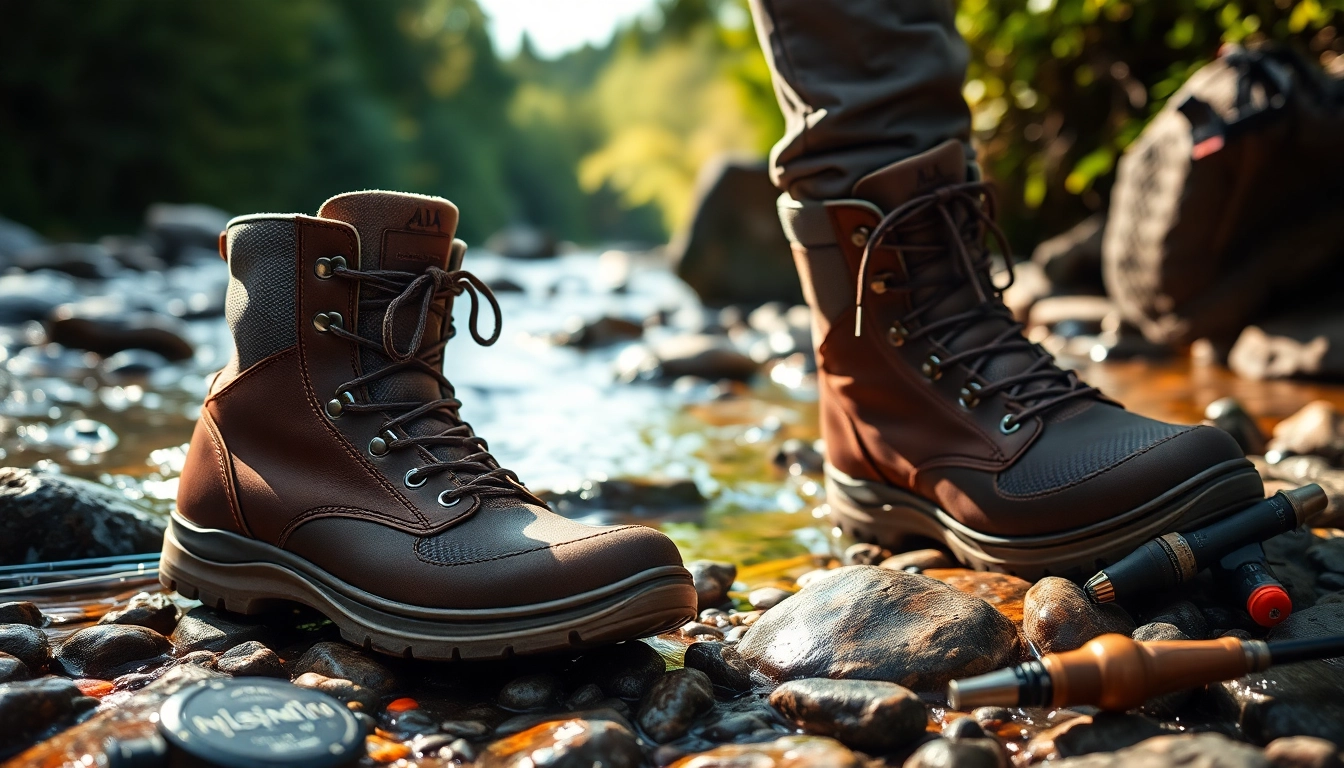Understanding Fly Fishing Boots: What to Look For
When embarking on a fly fishing adventure, one of the most essential pieces of gear you can own is a good pair of Fly fishing boots. Not only do they serve to protect your feet from the elements and rugged terrain, but they can greatly enhance your fishing experience by providing comfort, stability, and grip. In this section, we will delve into the key features, materials, and fitting considerations essential for selecting the perfect pair of fly fishing boots.
Key Features of Fly Fishing Boots
When shopping for fly fishing boots, you’ll encounter several key features that dictate their performance and usability:
- Traction: Fly fishing often involves wading through slippery rocks and riverbeds. Look for boots with aggressive outsoles that provide optimal grip.
- Stability: A well-designed boot should offer ankle support to prevent injury during treks over uneven surfaces.
- Drainage: Effective drainage systems are crucial; boots that allow water to escape keep your feet lighter and prevent waterlogging.
- Comfort: Cushioning and fit are key factors. Features like padded tongues, collars, and insoles can significantly enhance comfort.
- Durability: Given the challenging environments in which fly fishing often occurs, select boots made from high-quality materials that can withstand wear and tear.
Common Materials Used in Fly Fishing Boots
The materials used to construct fly fishing boots vary, and each has its advantages:
- Leather: Provides excellent durability and waterproofing but may require more maintenance.
- Synthetic Fabrics: Lighter and often more breathable, these materials tend to dry faster and require less upkeep.
- Neoprene: Typically used in waterproof boots, neoprene offers insulation and flexibility but can be less breathable.
- Felt and Rubber Soles: Each type has its unique benefits; felt soles are great for traction on slick surfaces, while rubber soles are more versatile across different terrains.
Importance of Proper Fit in Fly Fishing Boots
Having the right fit is vital not only for comfort but also for safety. Boots that are too tight can cause blisters and pain, while those that are too loose can make you prone to slips and accidents. Ensure that:
- Your heel should fit snugly to prevent lifting as you walk.
- There should be enough room to wiggle your toes.
- Try on boots with the socks you plan to wear during fishing for an accurate fit.
Types of Fly Fishing Boots: Which One is Right for You?
The diversity in fly fishing conditions means that various types of fly fishing boots are available, each suited to different needs. Selecting the right type is integral to your success and enjoyment on the water.
Felt Sole vs. Rubber Sole Fly Fishing Boots
One of the primary considerations in selecting fly fishing boots is the type of sole:
- Felt Soles: Known for their superior traction on slippery rocks, felt soles are particularly popular among fly fishers in freshwater environments. However, they can harbor invasive species if not properly cleaned.
- Rubber Soles: These provide better grip on both wet and dry surfaces and are often preferred in saltwater environments. They are more versatile but may not provide the same grip as felt on slick surfaces.
Boot Height and Ankle Support in Fly Fishing Boots
The height of fly fishing boots plays a significant role in ankle support:
- Low-Cut Boots: Suitable for warmer climates and shorter wading sessions, they provide flexibility and comfort.
- Mid-Cut Boots: A versatile option that offers a balance between mobility and ankle support.
- High-Cut Boots: Best for extreme conditions or deep wading, these boots provide significant protection and support, but may be less comfortable for long treks.
Waterproofing Techniques for Fly Fishing Boots
Keeping your feet dry while fishing is imperative for comfort and health. Pay attention to the waterproofing methods used in the construction of your boots:
- Seam-Sealed Construction: This involves sealing the seams with waterproof materials to prevent water ingress.
- Waterproof Membranes: Materials like Gore-Tex offer breathable waterproofing, allowing moisture to escape while preventing water entry.
- Durable Water Repellent (DWR) Coatings: These coatings enhance the water-resistance of fabrics but may need reapplication over time.
Maintaining Your Fly Fishing Boots: Best Practices
To extend the lifespan of your fly fishing boots, regular maintenance is essential. Here are some best practices:
Cleaning Techniques for Fly Fishing Boots
Proper cleaning after each use can prevent the buildup of dirt, grime, and odor:
- Rinse off sand, mud, and debris with clean water after each outing.
- Use a soft brush to scrub away stubborn dirt.
- Let your boots air dry, avoiding direct sunlight and heat sources which can damage materials.
Storage Tips to Extend Lifespan of Fly Fishing Boots
How you store your boots can have a significant impact on their longevity:
- Store boots in a cool, dry place away from direct sunlight.
- Use a boot tree or stuff them with newspaper to help retain their shape.
- Ensure boots are completely dry before storing to prevent mold and mildew.
Repair Options for Damaged Fly Fishing Boots
Even the best boots can suffer wear and tear. Here are some repair options:
- For small punctures in synthetic materials, use adhesive repair kits specifically designed for outdoor gear.
- Replace laces and buckles as needed to ensure a secure fit.
- Consider professional repairs for significant damage to seams or waterproof membranes.
Popular Brands and Models of Fly Fishing Boots
While we will not delve into specific brands, it’s essential to understand common features and considerations when choosing a model:
Top Features in Current Fly Fishing Boots
Modern fly fishing boots often come equipped with various features that enhance their usability. Look for boots that offer:
- Interchangeable soles for adaptable performance.
- Integrated drainage systems to quickly expel water.
- Lightweight and breathable materials for increased comfort during extended use.
User Reviews and Recommendations for Fly Fishing Boots
When considering which fly fishing boots to purchase, it’s helpful to read user reviews. Real-world experiences can provide insights into:
- Comfort levels over extended periods.
- Durability after multiple uses in various conditions.
- Ease of cleaning and maintenance.
Pricing Spectrum: What to Expect for Fly Fishing Boots
Pricing for fly fishing boots can vary widely. Generally, expect to pay:
- Budget: $80 – $150 for entry-level boots.
- Mid-Range: $150 – $300 for boots with better features and materials.
- Premium: $300 and up for high-end models with advanced technology and superior craftsmanship.
Advanced Tips for Choosing Fly Fishing Boots
For those looking to make an informed decision, consider the following advanced tips:
Expert Insights on Selecting Fly Fishing Boots
Consulting with experienced anglers or expert retailers can provide valuable insights into which boots will meet your specific needs based on:
- Your preferred fishing environment (freshwater vs. saltwater).
- The typical depth of water you’ll be wading through.
- Your local weather conditions and seasonal changes.
Comparing Performance of Different Fly Fishing Boots
Performance can fluctuate based on various factors including weight, sole type, and height. Take the time to:
- Test boots in person if possible, assessing how they feel with your fishing gear.
- Seek feedback on how different models perform on rocky river beds versus muddy banks.
- Analyze any features like BOA lacing systems that may benefit your fishing style.
Innovative Features to Look for in Fly Fishing Boots
New technologies are regularly introduced to enhance the fly fishing experience. Keep an eye out for:
- Quick-drying materials that maintain comfort and prevent sogginess.
- Enhanced traction patterns tailored to specific environments.
- Smart technologies that offer tracking or performance metrics if you’re inclined towards tech integration in outdoor activities.






Leave a Reply